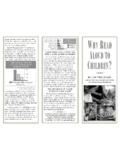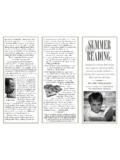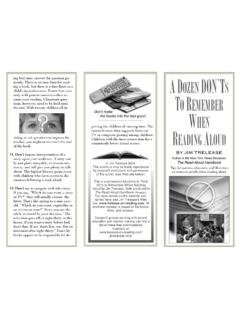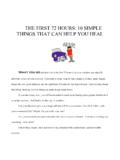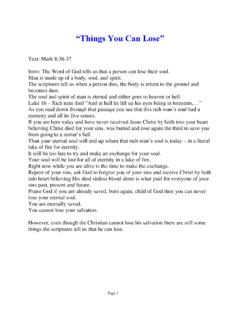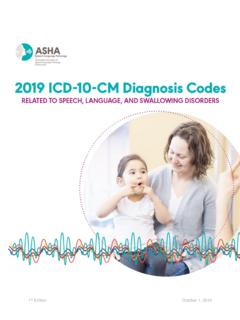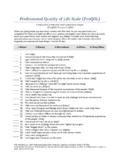Transcription of TEN FACTS Lamp 9. THE PARENTS SHOULD KNOW ABOUT …
1 You find in garage sales or thrift shops has the same words as a brand new copy for $ Reading families use the 3 B s (to help the 3 R s): Books, Bathroom, and Bed Lamp. Make sure there s a box for books and magazines in the bathroom for idle or captive moments, and add one near the kitchen table. Install a reading lamp near the child s bed and allow the privilege of staying up 15 minutes later to read (or just look at book s pictures) in bed. It might be the most important night-school he ll ever THERE is a strong connection between over-viewing of TV by children and under-achieving in school.
2 Simply put: those who watch the most know the least. Research shows that up to 10 TV-hours a week has no impact on children s grades but beyond that the grades decline. Sixty percent of children now have a TV in their bedroom. Oh-oh! A side-by-side comparison of third-graders math and reading scores tells it all in the chart below scores of children with or without a TV in their bedroom. The average child spends 1,460 hours a year watching TV/DVD s and playing computer games e-qual to watching Gone With the Wind 392 times year. What ABOUT buying those computer programs or tapes you see advertised on TV that teach reading?
3 Read on. 9. THE most economical device to teach read-ing is already in your home. Finland s chil-dren have the highest readingscores in the world and they use this devicemore than any other country and it s free! It s closed-captioning on the TV. Turn it on by using the menu button on the remote to reach the cc area. Children unconsciously absorb the sight of the words and their sounds, making connections to how print is used. It s like having a free magazine sub-scription in the home. All print counts. What ABOUT recorded books do they count? Read WHILE a recorded voice is not as good as a live adult who can stop and explain some-thing in the story, it s better than nothing.
4 It s also a great assist for the parent who has a reading disability or for whom English is a second language. (Incidentally, reading to a child in a foreign language accomplishes many of the same things feeds vocabulary and builds a bridge to the love of reading and books.) Public libraries have huge collections of audio books all available for FACTSPARENTS SHOULD KNOW ABOUT READINGBY JIM TRELEASEA uthor of the New York Times BestsellerThe Read-Aloud HandbookFor more details on these subjects, see Jim Tre-lease s Web site Jim Trelease 2009.
5 This brochure may be freely reproduced by nonprofit institutions withpermission of the author (see Web site). Archives of Pediatrics & Adolescent Medicine, 2005 Impact of TV-in-bedroomon student scoresMaecenas pulvinar sagittis enimLorem ipsum dolor sit amet, ligula suspendisse nulla pretium, rhoncus tempor placerat fermen-tum, enim integer ad volutpat. Nisl rhoncus turpis est, vel elit, congue wisi enim nunc ultricies sit, magna tincidunt. Maecenas aliquam maecenas ligula nostra, accumsan taciti. Lorem ipsum dolor sit amet, ligula suspendisse nulla pretium, rhon-cus tempor placerat. Lorem ipsum dolor sit amet, ligula suspendisse nulla pretium, Nisl rhoncus restaurants and order the food and beverages we like, not the stuff we hate.
6 So if you want to ensure children visit read-ing more often, make sure they like it more than they hate it. How do we get them to like it that much? Read READ aloud to them, even as infants. Ini-tially, the sound of your voice is a beacon of calmness, conditioning the child to associate you and the book with security. As the child grows, so too does the time you SHOULD spend reading in one sitting, from a few minutes to at least 20 minutes, from picture books to chapter books. I can see the benefits for younger children but I thought my 1st-grader was supposed to come home and read to me.
7 How can he get better at reading if I m doing the read-ing? Read the next LISTENING comprehension comes before reading comprehension. You must hear a word before you can say it or read and write it. If you ve never heard the word enor-mous in a meaningful way, you won t un-derstand it when it s time to read or write it. There s a kind of word reservoir in a child s brain and one of the jobs of a parent is to pour so many words into it that it overflows into speech and then reading and writing. By age four, high-income children have heard 45 million words from their families and low-income children have heard just 13 million.
8 That s a 32 million-word difference equalling one year s head-start for the advantaged child. HUGE FACTOR: a child spends 900 hours a year in school and 7,800 hours at home. Who s the most important teacher? At what age do you stop reading to a child? Read CHILDREN usually read on one level and listen on a higher level. It s usually not until eighth grade that the reading level catches up to the listening level. This means that first-graders can hear and understand third- and fourth-grade books they can t read yet. These chapter books gradually introduce them to new words, new ideas, and the world beyond their neighbor-hood and that, in turn, helps them better understand what they need to read in their school books.
9 Simple sentences in Dr. Seuss books like Hop on Pop were writ-ten to be read by beginning readers to themselves; that s why the cover label reads I Can Read It All by Myself. Six-year-olds are capable of understanding sen-tences that are longer and richer than All Fall. Fall off the wall but an adult must help by reading richer sentences like, Mr. McGregor was on his hands and knees planting out cabbages, but he jumped up and ran after Peter, waving a rake and call-ing out, Stop thief! (The Tale of Peter Rabbit) What ABOUT families that can t afford books?
10 Read THE top winter Olympians come from states where they have the most ice and snow. And reading research shows that children who come from homes with the most print books, magazines, and news-papers have the highest reading scores. They also use the library more than those with lower scores. Libraries have the most and best books in the world all for free. Remember: a used book for 50 cents like 1. READING is the most important subject in school. Why? Because a child needs reading in order to master most of the other subjects. It s extremely difficult to do word problems in math if you can t read the words.
